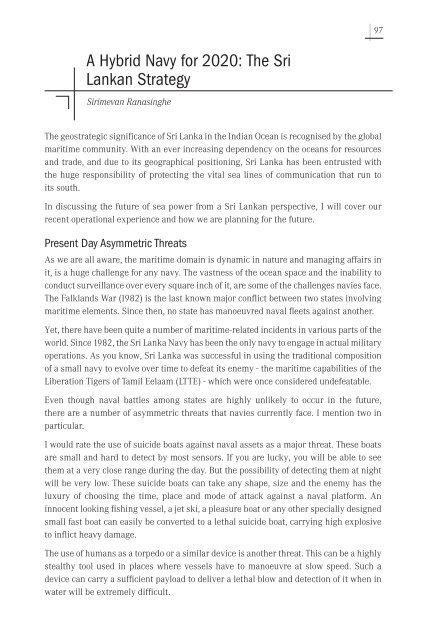THE FUTURE OF SEA POWER
SPC2015_Proceedings
SPC2015_Proceedings
You also want an ePaper? Increase the reach of your titles
YUMPU automatically turns print PDFs into web optimized ePapers that Google loves.
| 97<br />
A Hybrid Navy for 2020: The Sri<br />
Lankan Strategy<br />
Sirimevan Ranasinghe<br />
The geostrategic significance of Sri Lanka in the Indian Ocean is recognised by the global<br />
maritime community. With an ever increasing dependency on the oceans for resources<br />
and trade, and due to its geographical positioning, Sri Lanka has been entrusted with<br />
the huge responsibility of protecting the vital sea lines of communication that run to<br />
its south.<br />
In discussing the future of sea power from a Sri Lankan perspective, I will cover our<br />
recent operational experience and how we are planning for the future.<br />
Present Day Asymmetric Threats<br />
As we are all aware, the maritime domain is dynamic in nature and managing affairs in<br />
it, is a huge challenge for any navy. The vastness of the ocean space and the inability to<br />
conduct surveillance over every square inch of it, are some of the challenges navies face.<br />
The Falklands War (1982) is the last known major conflict between two states involving<br />
maritime elements. Since then, no state has manoeuvred naval fleets against another.<br />
Yet, there have been quite a number of maritime-related incidents in various parts of the<br />
world. Since 1982, the Sri Lanka Navy has been the only navy to engage in actual military<br />
operations. As you know, Sri Lanka was successful in using the traditional composition<br />
of a small navy to evolve over time to defeat its enemy - the maritime capabilities of the<br />
Liberation Tigers of Tamil Eelaam (LTTE) - which were once considered undefeatable.<br />
Even though naval battles among states are highly unlikely to occur in the future,<br />
there are a number of asymmetric threats that navies currently face. I mention two in<br />
particular.<br />
I would rate the use of suicide boats against naval assets as a major threat. These boats<br />
are small and hard to detect by most sensors. If you are lucky, you will be able to see<br />
them at a very close range during the day. But the possibility of detecting them at night<br />
will be very low. These suicide boats can take any shape, size and the enemy has the<br />
luxury of choosing the time, place and mode of attack against a naval platform. An<br />
innocent looking fishing vessel, a jet ski, a pleasure boat or any other specially designed<br />
small fast boat can easily be converted to a lethal suicide boat, carrying high explosive<br />
to inflict heavy damage.<br />
The use of humans as a torpedo or a similar device is another threat. This can be a highly<br />
stealthy tool used in places where vessels have to manoeuvre at slow speed. Such a<br />
device can carry a sufficient payload to deliver a lethal blow and detection of it when in<br />
water will be extremely difficult.


